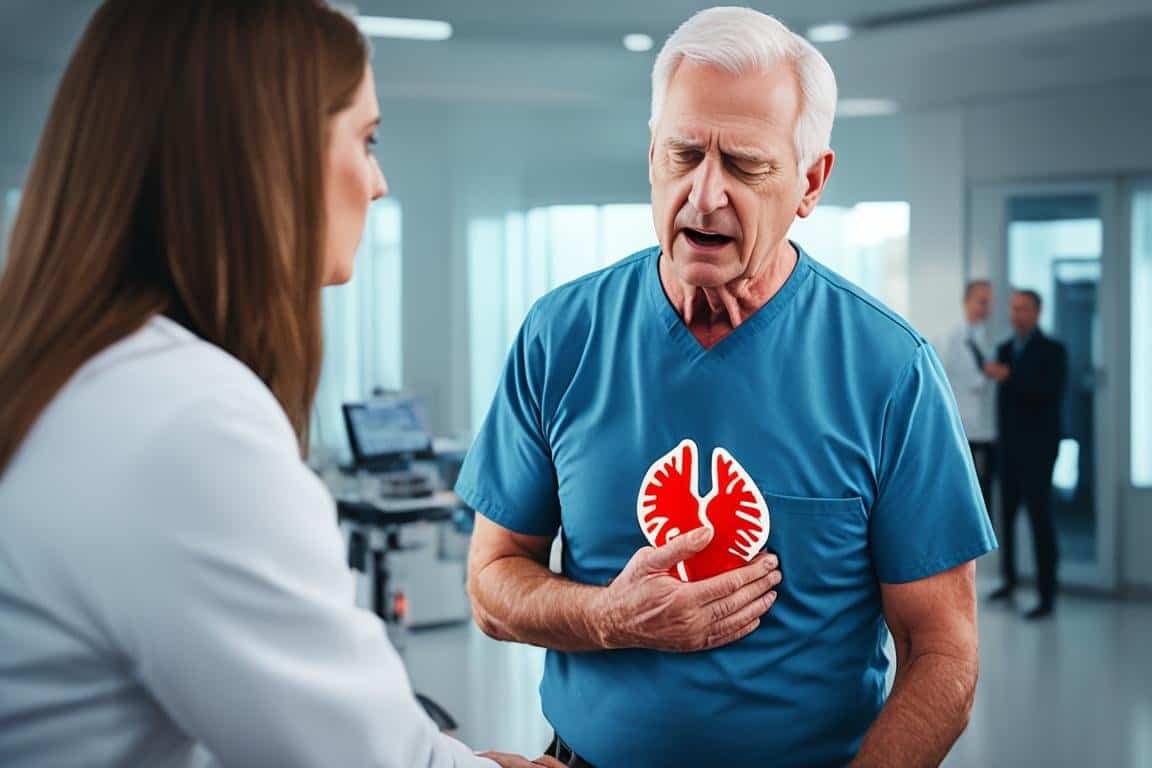In the first 60 minutes of a heart attack, immediate actions can significantly improve outcomes. Prompt recognition and response are crucial in saving a person’s life during this critical time. The American Heart Association recommends the following steps within the first hour of a heart attack:
1. Call for emergency medical assistance: Dial your country’s emergency service provider immediately if you or someone around you experiences signs of a heart attack.
2. Stay calm and reassure the person: Encourage the person to sit down and try to keep them calm while waiting for help to arrive.
3. Assist with prescribed medication: If the person has been prescribed nitroglycerin, you can help them take it as directed.
4. Perform CPR if necessary: If the person becomes unresponsive and stops breathing, initiate CPR (cardiopulmonary resuscitation) with chest compressions until help arrives.
5. Don’t delay seeking medical help: Don’t wait to see if the symptoms subside on their own. Quick medical intervention is crucial for a positive outcome.
By taking these immediate actions, you can play a vital role in increasing the chances of survival and minimizing heart damage during the first 60 minutes of a heart attack.
Key Takeaways:
- Recognize the signs of a heart attack and respond promptly.
- Call emergency medical assistance without delay.
- Stay calm, reassure the person, and assist with prescribed medication if available.
- Perform CPR if necessary until professional help arrives.
- Don’t wait, seek immediate medical help and don’t ignore the symptoms.
Recognizing the Signs of Cardiac Arrest
Cardiac arrest can occur suddenly and without warning. It is crucial to be able to recognize the signs and symptoms of cardiac arrest to initiate immediate actions and potentially save a life. The fast actions taken within the first hour of a heart attack can significantly impact the outcome.
Here are some emergency steps for handling a heart attack:
- Call emergency services immediately to seek medical help.
- If the person is unresponsive and not breathing, begin CPR (Cardiopulmonary Resuscitation) by performing chest compressions. If you are not trained in CPR, the emergency operator can guide you.
- Use an Automated External Defibrillator (AED), if available, to deliver an electric shock to the heart to restore its normal rhythm.
- Administer aspirin to the person, if possible, as it may help prevent blood clots.
It is essential to remember that these emergency steps are not substitutes for professional medical care. They are immediate actions that can be taken while waiting for medical help to arrive.

| Signs and Symptoms of Cardiac Arrest: |
|---|
| Loss of consciousness |
| No pulse or breathing |
| Sudden collapse |
| Unresponsiveness |
| No signs of life |
Understanding the Difference Between a Heart Attack and Cardiac Arrest
To effectively respond to a medical emergency, such as an acute heart condition, it is crucial to understand the difference between a heart attack and cardiac arrest. Although these terms are often used interchangeably, they refer to distinct medical events with varying implications.
An individual experiences a heart attack when the blood flow to the heart is obstructed, typically due to a blockage in one or more coronary arteries. This interruption in blood supply can result in damaged or dying heart muscle cells. It is imperative to recognize the early symptoms of a heart attack, including:
- Chest pain or discomfort – A sensation of pressure, squeezing, heaviness, or burning in the chest that may extend to the arms, neck, jaw, or back
- Shortness of breath – Difficulty breathing or a feeling of breathlessness
- Nausea, vomiting, or indigestion – Digestive discomfort accompanied by general unease
- Cold sweats and lightheadedness – Profuse sweating and feeling dizzy or faint
On the other hand, cardiac arrest occurs when the heart suddenly stops beating due to an electrical malfunction. This disruption halts the heart’s mechanical activity, resulting in the absence of blood flow throughout the body. Urgent intervention is necessary to restore the heart’s normal rhythm and circulation. While a heart attack can sometimes lead to a cardiac arrest, these are distinct conditions.

Recognizing the symptoms of a heart attack and taking immediate and appropriate measures within the first 60 minutes are essential to prevent further damage and increase the chances of recovery. If you or someone around you experiences any signs of a heart attack, it is crucial to seek medical help immediately. Call emergency services and follow the instructions provided while waiting for professional assistance to arrive.
Remember, every second counts during a heart attack, and prompt action can save lives. Stay vigilant and be aware of the symptoms to ensure you can take urgent measures for a heart attack when every moment matters.
Early Symptoms and Identification of a Heart Attack
Identifying the early symptoms of a heart attack is crucial for early intervention. While chest pain is a common symptom, it may present differently in each person. Other symptoms to watch out for include discomfort in the chest, radiating pain to other body parts, shortness of breath, nausea, vomiting, or cold sweats. It is important to recognize these warning signs to initiate the appropriate care within the first 60 minutes of a heart attack.
Recognizing these symptoms promptly can help ensure that the initial care for heart attack patients follows the 60-minute heart attack protocol. By understanding and responding to these warning signs, you can take the necessary steps to save a life during this critical time.
| Early Symptoms of a Heart Attack |
|---|
| Chest pain or discomfort |
| Radiating pain to other body parts |
| Shortness of breath |
| Nausea or vomiting |
| Cold sweats |
It’s important to note that not everyone experiences the typical chest pain during a heart attack. Some individuals may only experience mild discomfort or pain in other areas of the body, such as the arms, back, jaw, or neck. Additionally, women may experience symptoms that are distinct from those experienced by men, including shortness of breath, nausea, or fatigue.
Regardless of the specific symptoms, it’s crucial to take any signs of a heart attack seriously and seek immediate medical attention. Remember, early intervention and following the 60-minute heart attack protocol can make a significant difference in the outcome.
Emergency Treatment Before Medical Help Arrives
In the event of a heart attack, it is crucial to take immediate action and seek immediate medical help. Remember, time is of the essence when it comes to a heart attack emergency. The first step is to call the emergency service provider immediately at 911 or the designated emergency number in your country.
While waiting for medical help to arrive, there are some actions you can take that may potentially save a person’s life. It is important to stay calm and reassure the person experiencing the heart attack. Encourage them to sit in a comfortable position and try to keep them as relaxed as possible.
If the person is conscious and not allergic to aspirin, giving them an aspirin tablet (325 milligrams) to chew and swallow can help alleviate some of the symptoms. Aspirin is known to thin the blood and can improve blood flow to the heart, reducing further damage.
It is important to closely monitor the person’s vital signs. If they become unresponsive and stop breathing, immediate CPR (cardiopulmonary resuscitation) should be initiated. If you are trained in CPR, begin chest compressions and rescue breaths. If you are not trained, providing hands-only CPR by performing chest compressions at a rate of 100-120 compressions per minute can still make a significant difference until medical help arrives.
Remember, every second counts when it comes to a heart attack. Taking immediate action and providing any necessary emergency treatment before medical help arrives can greatly increase the chances of a positive outcome. Stay calm, act swiftly, and seek immediate medical assistance for the best chances of survival.
Conclusion
The first 60 minutes after a heart attack are crucial in determining the outcome. Immediate actions within this timeframe can significantly improve your chances of survival. Recognizing the signs of cardiac arrest, understanding the difference between a heart attack and cardiac arrest, and knowing the early symptoms are all essential in handling a heart attack within the first hour.
By following the recommended steps and seeking prompt medical help, lives can be saved during this critical time. Time is of the essence when it comes to a heart attack, so act quickly and seek immediate medical assistance. Remember, early treatment and intervention are key to a successful heart attack treatment.
If you or someone around you experiences the warning signs of a heart attack, do not delay in taking action. Call emergency services and begin performing CPR if needed. Together, we can make a difference in handling heart attacks within the first hour and improving outcomes for individuals in need of immediate care.

